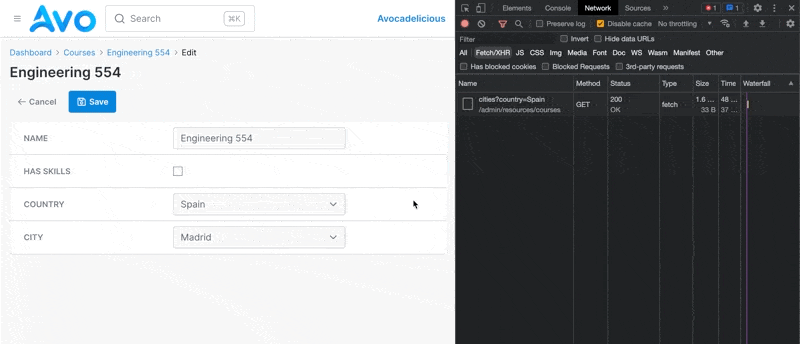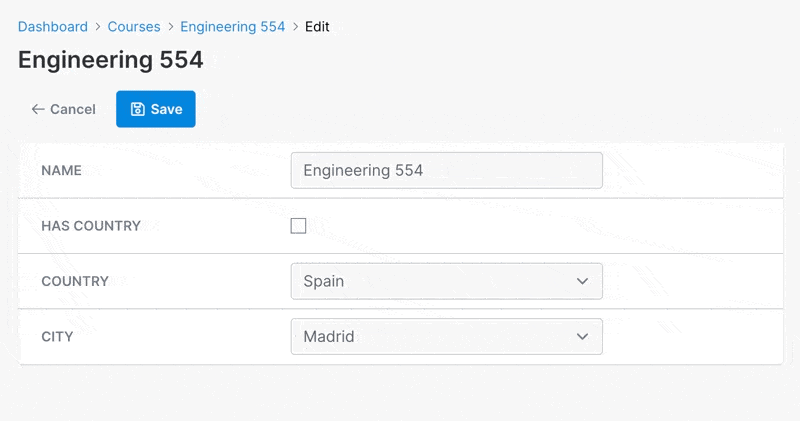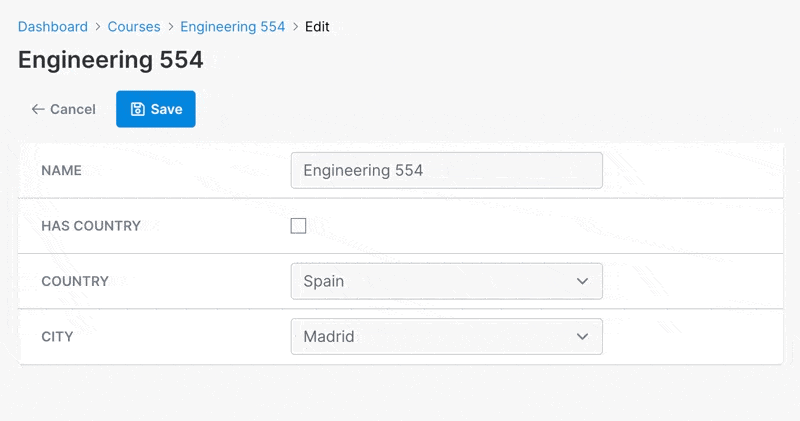Stimulus JS & HTML attributes
WARNING
This feature is in the beta phase. The API might change while seeing how the community uses it to build their apps. This is not the dependable fields feature but a placeholder so we can observe and see what we need to ship to make it helpful to you.
What we'll be able to do at the end of reading these docs

INFO
Please note that in order to have the JS code from your controllers loaded in Avo you'll need to add your asset pipeline using these instructions. It's really easier than it sounds. It's like you'd add a new JS file to your regular Rails app.
One of the most requested features is the ability to make the forms more dynamic. We want to bring the first iteration of this feature through Stimulus JS integration. This light layer will allow you to hook into the views and inject your functionality with Stimulus JS.
You'll be able to add your Stimulus controllers to the resource views (Index, Show, Edit, and New), attach classes, style, and data attributes to the fields and inputs in different views.
Assign Stimulus controllers to resource views
To enable a stimulus controller to resource view, you can use the stimulus_controllers option on the resource file.
class Avo::Resources::Course < Avo::BaseResource
self.stimulus_controllers = "course-resource"
endYou can add more and separate them by a space character.
class Avo::Resources::Course < Avo::BaseResource
self.stimulus_controllers = "course-resource select-field association-fields"
endAvo will add a resource-[VIEW] (resource-edit, resource-show, or resource-index) controller for each view.
Field wrappers as targets
By default, Avo will add stimulus target data attributes to all field wrappers. The notation scheme uses the name and field type [FIELD_NAME][FIELD_TYPE]WrapperTarget.
# Wrappers get the `data-[CONTROLLER]-target="nameTextWrapper"` attribute and can be targeted using nameTextWrapperTarget
field :name, as: :text
# Wrappers get the `data-[CONTROLLER]-target="createdAtDateTimeWrapper"` attribute and can be targeted using createdAtDateTimeWrapperTarget
field :created_at, as: :date_time
# Wrappers get the `data-[CONTROLLER]-target="hasSkillsTagsWrapper"` attribute and can be targeted using hasSkillsTagsWrapperTarget
field :has_skills, as: :tagsFor example for the following stimulus controllers self.stimulus_controllers = "course-resource select-field association-fields" Avo will generate the following markup for the has_skills field above on the edit view.
<div class="relative flex flex-col md:flex-row md:items-center pb-2 md:pb-0 leading-tight min-h-14" data-field-id="has_skills" data-field-type="boolean" data-resource-edit-target="hasSkillsBooleanWrapper" data-course-resource-target="hasSkillsBooleanWrapper" data-select-field-target="hasSkillsBooleanWrapper" data-association-fields-target="hasSkillsBooleanWrapper">
<!-- Rest of the field content -->
</div>You can add those targets to your controllers and use them in your JS code.
Field inputs as targets
Similar to the wrapper element, inputs in the Edit and New views get the [FIELD_NAME][FIELD_TYPE]InputTarget. On more complex fields like the searchable, polymorphic belongs_to field, where there is more than one input, the target attributes are attached to all input, select, and button elements.
# Inputs get the `data-[CONTROLLER]-target="nameTextInput"` attribute and can be targeted using nameTextInputTarget
field :name, as: :text
# Inputs get the `data-[CONTROLLER]-target="createdAtDateTimeInput"` attribute and can be targeted using createdAtDateTimeInputTarget
field :created_at, as: :date_time
# Inputs get the `data-[CONTROLLER]-target="hasSkillsTagsInput"` attribute and can be targeted using hasSkillsTagsInputTarget
field :has_skills, as: :tagsAll controllers receive the view value
All stimulus controllers receive the view attribute in the DOM.
<div class="space-y-12" data-model-id="280" data-controller="resource-edit course-resource" data-resource-edit-view-value="edit" data-course-resource-view-value="edit">
<!-- The fields and panels -->
</div>Now you can use that inside your Stimulus JS controller like so:
import { Controller } from '@hotwired/stimulus'
export default class extends Controller {
static values = {
view: String,
}
async connect() {
console.log('view ->', this.viewValue)
}
}The possible values are index, show, edit, or new
Assign Stimulus controllers to actions
Similarly as to resource, you can assign stimulus controller to an action. To do that you can use the stimulus_controllers option on the action file.
class Avo::Actions::ShowCurrentTime < Avo::BaseAction
self.stimulus_controllers = "city-in-country"
endYou can add more and separate them by a space character.
class Avo::Actions::ShowCurrentTime < Avo::BaseAction
self.stimulus_controllers = "course-resource select-field association-fields"
endThe same way as for the resources, Avo will add stimulus target data attributes to all field wrappers and all input fields.
Unlike with the resource, Avo will not add a specific default controller for each type of the view (index, show, edit). Same way, the controllers will not receive the view attribute in the DOM, as in case of resources.
Attach HTML attributes
Composing the attributes together
You can use the attributes together to make your fields more dynamic.
field :has_skills, as: :boolean, html: {
edit: {
input: {
data: {
# On click run the toggleSkills method on the toggle-fields controller
action: "input->toggle-fields#toggleSkills",
}
}
}
}
field :skills, as: :tags, html: {
edit: {
wrapper: {
# hide this field by default
classes: "hidden"
}
}
}// toggle_fields_controller.js
import { Controller } from "@hotwired/stimulus";
export default class extends Controller {
static targets = ["skillsTagsWrapper"]; // use the target Avo prepared for you
toggleSkills() {
this.skillsTagsWrapperTarget.classList.toggle("hidden");
}
}Pre-made stimulus methods
Avo ships with a few JS methods you may use on your resources.
resource-edit#toggle
On your Edit views, you can use the resource-edit#toggle method to toggle the field visibility from another field.
field :has_country, as: :boolean, html: {
edit: {
input: {
data: {
action: "input->resource-edit#toggle", # use the pre-made stimulus method on input
resource_edit_toggle_target_param: "countrySelectWrapper", # target to be toggled
# resource_edit_toggle_targets_param: ["countrySelectWrapper"] # add more than one target
}
}
}
}
field :country, as: :select, options: Course.countries.map { |country| [country, country] }.to_h
resource-edit#disable
Disable works similarly to toggle, with the difference that it disables the field instead of hiding it.
field :has_skills, as: :boolean, html: {
edit: {
input: {
data: {
action: "input->resource-edit#disable", # use the pre-made stimulus method on input
resource_edit_disable_target_param: "countrySelectInput", # target to be disabled
# resource_edit_disable_targets_param: ["countrySelectWrapper"] # add more than one target to disable
}
}
}
}
field :country, as: :select, options: Course.countries.map { |country| [country, country] }.to_h
You may also target the wrapper element for that field if the target field has more than one input like the searchable polymorphic belongs_to field.
field :has_skills, as: :boolean, html: {
edit: {
input: {
data: {
action: "input->resource-edit#disable", # use the pre-made stimulus method on input
resource_edit_disable_target_param: "countrySelectWrapper", # target the wrapper so all inputs are disabled
# resource_edit_disable_targets_param: ["countrySelectWrapper"] # add more than one target to disable
}
}
}
}
field :country, as: :select, options: Course.countries.map { |country| [country, country] }.to_hresource-edit#debugOnInput
For debugging purposes only, the resource_edit Stimulus JS controller provides the debugOnInput method that outputs the event and value for an action to the console. Use this just to make sure you targeted your fields correctly. It doesn't have any real use.

Custom Stimulus controllers
Watch the demo videoCheck the source code
If you visit our demo website on the course edit page you can see this in action.
- Demo of the feature in action
https://main.avodemo.com/avo/resources/courses/1/edit - JS controller that does that change
https://github.com/avo-hq/main.avodemo.com/blob/main/app/javascript/controllers/course_controller.js - Rails controller that returns the results
https://github.com/avo-hq/main.avodemo.com/blob/main/app/controllers/avo/courses_controller.rb#L3 - Stimulus action that triggers the update
https://github.com/avo-hq/main.avodemo.com/blob/main/app/avo/resources/course.rb#L68
The bigger purpose of this feature is to create your own Stimulus JS controllers to bring the functionality you need to the CRUD interface.
Below is an example of how you could implement a city & country select feature where the city select will have its options changed when the user selects a country:
- Add an action to the country select to trigger a change.
- The stimulus method
onCountryChangewill be triggered when the user changes the country. - That will trigger a fetch from the server where Rails will return an array of cities for the provided country.
- The city field will have a
loadingstate while we fetch the results. - The cities will be added to the
cityselect field - If the initial value is present in the returned results, it will be selected.
- All of this will happen only on the
NewandEditviews because of the condition we added to theconnectmethod.
# app/avo/resources/course.rb
class Avo::Resources::Course < Avo::BaseResource
self.stimulus_controllers = "course-resource"
def fields
field :id, as: :id
field :name, as: :text
field :country, as: :select, options: Course.countries.map { |country| [country, country] }.to_h, html: {
edit: {
input: {
data: {
course_resource_target: "countryFieldInput", # Make the input a target
action: "input->course-resource#onCountryChange" # Add an action on change
}
}
}
}
field :city, as: :select, options: Course.cities.values.flatten.map { |city| [city, city] }.to_h, html: {
edit: {
input: {
data: {
course_resource_target: "cityFieldInput" # Make the input a target
}
}
}
}
end
endRails.application.routes.draw do
if defined? ::Avo
Avo::Engine.routes.draw do
scope :resources do
get "courses/cities", to: "courses#cities"
end
end
end
endclass Avo::CoursesController < Avo::ResourcesController
def cities
render json: get_cities(params[:country]) # return an array of cities based on the country we received
end
private
def get_cities(country)
return [] unless Course.countries.include?(country)
Course.cities[country.to_sym]
end
endclass Course < ApplicationRecord
def self.countries
["USA", "Japan", "Spain", "Thailand"]
end
def self.cities
{
USA: ["New York", "Los Angeles", "San Francisco", "Boston", "Philadelphia"],
Japan: ["Tokyo", "Osaka", "Kyoto", "Hiroshima", "Yokohama", "Nagoya", "Kobe"],
Spain: ["Madrid", "Valencia", "Barcelona"],
Thailand: ["Chiang Mai", "Bangkok", "Phuket"]
}
end
endimport { Controller } from "@hotwired/stimulus";
const LOADER_CLASSES = "absolute bg-gray-100 opacity-10 w-full h-full";
export default class extends Controller {
static targets = ["countryFieldInput", "cityFieldInput", "citySelectWrapper"];
static values = {
view: String,
};
// Te fields initial value
static initialValue;
get placeholder() {
return this.cityFieldInputTarget.ariaPlaceholder;
}
set loading(isLoading) {
if (isLoading) {
// create a loader overlay
const loadingDiv = document.createElement("div");
loadingDiv.className = LOADER_CLASSES;
loadingDiv.dataset.target = "city-loader";
// add the loader overlay
this.citySelectWrapperTarget.prepend(loadingDiv);
this.citySelectWrapperTarget.classList.add("opacity-50");
} else {
// remove the loader overlay
this.citySelectWrapperTarget
.querySelector('[data-target="city-loader"]')
.remove();
this.citySelectWrapperTarget.classList.remove("opacity-50");
}
}
async connect() {
// Add the controller functionality only on forms
if (["edit", "new"].includes(this.viewValue)) {
this.captureTheInitialValue();
// Trigger the change on load
await this.onCountryChange();
}
}
// Read the country select.
// If there's any value selected show the cities and prefill them.
async onCountryChange() {
if (this.hasCountryFieldInputTarget && this.countryFieldInputTarget) {
// Get the country
const country = this.countryFieldInputTarget.value;
// Dynamically fetch the cities for this country
const cities = await this.fetchCitiesForCountry(country);
// Clear the select of options
Object.keys(this.cityFieldInputTarget.options).forEach(() => {
this.cityFieldInputTarget.options.remove(0);
});
// Add blank option
this.cityFieldInputTarget.add(new Option(this.placeholder));
// Add the new cities
cities.forEach((city) => {
this.cityFieldInputTarget.add(new Option(city, city));
});
// Check if the initial value is present in the cities array and select it.
// If not, select the first item
const currentOptions = Array.from(this.cityFieldInputTarget.options).map(
(item) => item.value
);
if (currentOptions.includes(this.initialValue)) {
this.cityFieldInputTarget.value = this.initialValue;
} else {
// Select the first item
this.cityFieldInputTarget.value =
this.cityFieldInputTarget.options[0].value;
}
}
}
// Private
captureTheInitialValue() {
this.initialValue = this.cityFieldInputTarget.value;
}
async fetchCitiesForCountry(country) {
if (!country) {
return [];
}
this.loading = true;
const response = await fetch(
`${window.Avo.configuration.root_path}/resources/courses/cities?country=${country}`
);
const data = await response.json();
this.loading = false;
return data;
}
}This is how the fields behave with this Stimulus JS controller.

Use Stimulus JS in a tool
There are a few steps you need to take in order to register the Stimulus JS controller in the current app context.
First, you need to have a JS entrypoint (ex: avo.custom.js) and have that loaded in the _head partial. For instructions on that please follow these steps to add it to your app (importmaps or esbuild).
Set up a controller
// app/javascript/controllers/sample_controller.js
import { Controller } from "@hotwired/stimulus";
export default class extends Controller {
connect() {
console.log("Hey from sample controller 👋");
}
}Register that controller with the current Stimulus app
// app/javascript/avo.custom.js
import SampleController from "controllers/sample_controller";
// Hook into the stimulus instance provided by Avo
const application = window.Stimulus;
application.register("course-resource", SampleController);
// eslint-disable-next-line no-console
console.log("Hi from Avo custom JS 👋");Use the controller in the Avo tool
<!-- app/views/avo/_sample_tool.html.erb -->
<div data-controller="sample">
<!-- content here -->
</div>Done 🙌 Now you have a controller connecting to a custom Resource tool or Avo tool (or Avo views).
 Friendly.rb - Your friendly European Ruby Conference
Friendly.rb - Your friendly European Ruby Conference